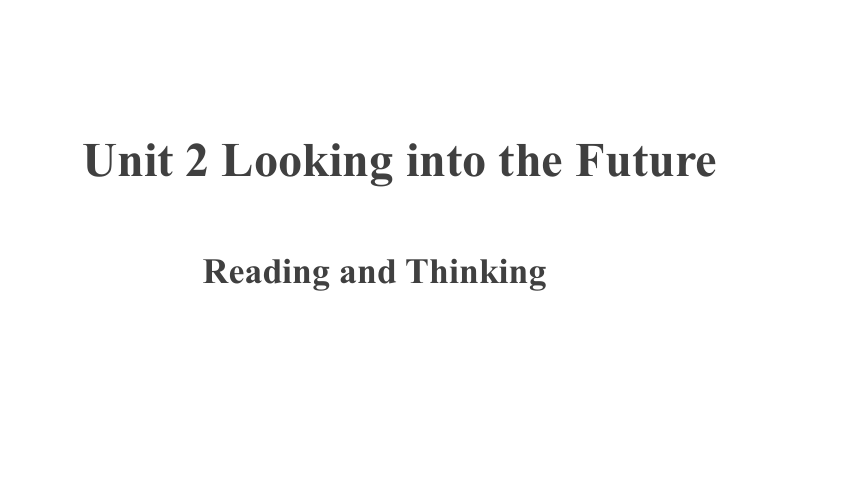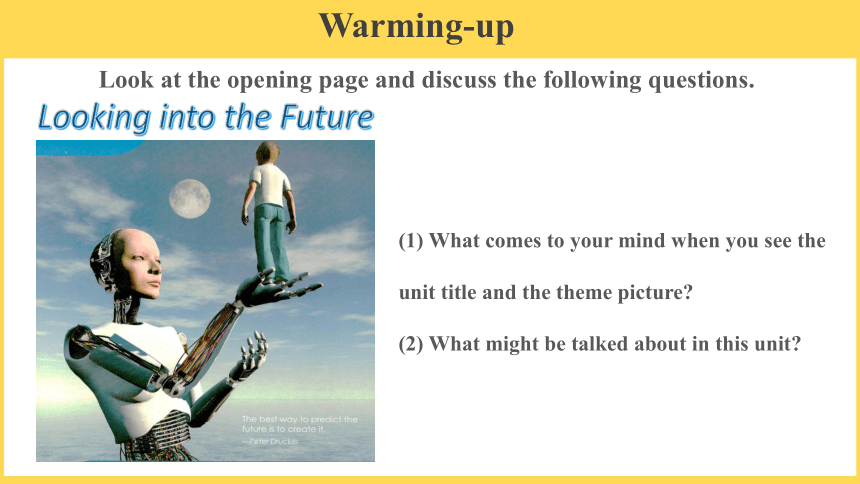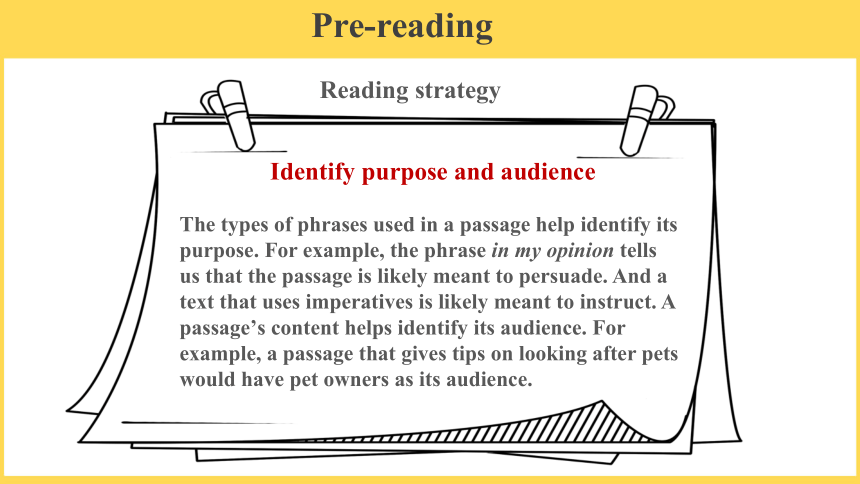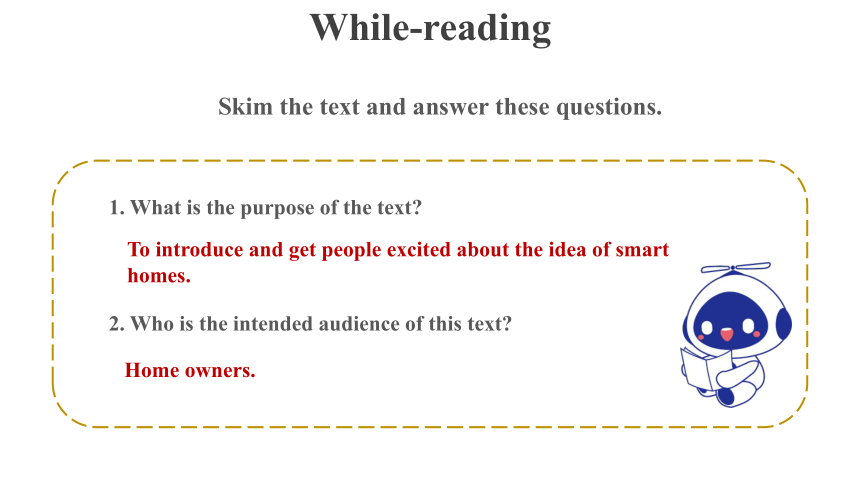人教版(2019) 选择性必修 第一册 Unit 2 Looking into the Future Reading and Thinking 课件(共14张PPT)
文档属性
| 名称 | 人教版(2019) 选择性必修 第一册 Unit 2 Looking into the Future Reading and Thinking 课件(共14张PPT) |  | |
| 格式 | pptx | ||
| 文件大小 | 1.5MB | ||
| 资源类型 | 教案 | ||
| 版本资源 | 人教版(2019) | ||
| 科目 | 英语 | ||
| 更新时间 | 2024-05-18 16:10:20 | ||
图片预览







文档简介
(共14张PPT)
Unit 2 Looking into the Future
Reading and Thinking
Warming-up
(1) What comes to your mind when you see the unit title and the theme picture
(2) What might be talked about in this unit
Look at the opening page and discuss the following questions.
Looking into the Future
Warming-up
Appreciate the quote and think about the questions.
The best way to predict the future is to create it.
—Peter Drucker
How do you understand the quote
What’s the possible connection between the quote and the picture
What’s the relationship between man and technology likely to be in the future
Pre-reading
Brain storming: What are the smart products in our life
Floor sweeping robot
Smart robot
Smart watch
Smart speaker
Pre-reading
What does it mean when we say that something such as a phone is “smart”
What do you think a “smart” house can do that other houses cannot
Before reading, discuss these questions in groups.
To say that something is smart means that it can make decisions on its own without a human telling it what to do, and that it can also learn how to do things itself.
I would expect that a smart house could control room temperature and lights, for example.
Pre-reading
Reading strategy
The types of phrases used in a passage help identify its purpose. For example, the phrase in my opinion tells us that the passage is likely meant to persuade. And a text that uses imperatives is likely meant to instruct. A passage’s content helps identify its audience. For example, a passage that gives tips on looking after pets would have pet owners as its audience.
Identify purpose and audience
While-reading
Skim the text and answer these questions.
1. What is the purpose of the text
2. Who is the intended audience of this text
To introduce and get people excited about the idea of smart homes.
Home owners.
While-reading
Read the text again and fill in the table below.
In the future, what will smart homes do about … doors dinners
TVs, computers beds
water pipes, electrical wires toilets
lights, favourite music, or TV programmes lock the door for us when we are away
prepare dinner for us
switch off TVs and computers when we forget
record how well we sleep every night, check our body weight, ...
detect if there is a problem and provide us with the relevant information
keep constant track of our health and warn us early on if there is something wrong
come on the instant we enter the door
While-reading
Read the passage again and think about the questions below.
What chores do we have to do today
How do smart homes make life easier in the future
What advantages do smart homes have
What is the writer’s attitude towards smart homes How do you know that
Post-reading
Complete the summary using the correct forms of the words from the text.
A smart home is one that i computers into the structure of the building itself. In this way, many of the things that we now do ourselves will become a . For example, the smart home could control the air conditioning and lights so that you would no longer have to turn s on and off, making your home more energy-e .
ntegrates
utomatic
witches
fficient
Post-reading
The smart home could also m itself to make sure that everything is working as it should, and send you w if there is a problem. Such smart homes could even be programmed to d your health problems, and then give you r advice as to the food you should eat or if you should see a doctor. So, in a sense, smart homes will lead us to living smarter lives.
onitor
arnings
etect
elevant
Post-reading
In what way is the home of tomorrow already
the home of today
What might be some of the disadvantages of
smart homes
Discuss these questions in groups.
Assignment
Write a short passage to describe your ideal smart home.
It should include:
1. what smart devices there are in your home;
2. their functions;
3. your attitude towards the smart technology and your reasons.
Goodbye!
Unit 2 Looking into the Future
Reading and Thinking
Warming-up
(1) What comes to your mind when you see the unit title and the theme picture
(2) What might be talked about in this unit
Look at the opening page and discuss the following questions.
Looking into the Future
Warming-up
Appreciate the quote and think about the questions.
The best way to predict the future is to create it.
—Peter Drucker
How do you understand the quote
What’s the possible connection between the quote and the picture
What’s the relationship between man and technology likely to be in the future
Pre-reading
Brain storming: What are the smart products in our life
Floor sweeping robot
Smart robot
Smart watch
Smart speaker
Pre-reading
What does it mean when we say that something such as a phone is “smart”
What do you think a “smart” house can do that other houses cannot
Before reading, discuss these questions in groups.
To say that something is smart means that it can make decisions on its own without a human telling it what to do, and that it can also learn how to do things itself.
I would expect that a smart house could control room temperature and lights, for example.
Pre-reading
Reading strategy
The types of phrases used in a passage help identify its purpose. For example, the phrase in my opinion tells us that the passage is likely meant to persuade. And a text that uses imperatives is likely meant to instruct. A passage’s content helps identify its audience. For example, a passage that gives tips on looking after pets would have pet owners as its audience.
Identify purpose and audience
While-reading
Skim the text and answer these questions.
1. What is the purpose of the text
2. Who is the intended audience of this text
To introduce and get people excited about the idea of smart homes.
Home owners.
While-reading
Read the text again and fill in the table below.
In the future, what will smart homes do about … doors dinners
TVs, computers beds
water pipes, electrical wires toilets
lights, favourite music, or TV programmes lock the door for us when we are away
prepare dinner for us
switch off TVs and computers when we forget
record how well we sleep every night, check our body weight, ...
detect if there is a problem and provide us with the relevant information
keep constant track of our health and warn us early on if there is something wrong
come on the instant we enter the door
While-reading
Read the passage again and think about the questions below.
What chores do we have to do today
How do smart homes make life easier in the future
What advantages do smart homes have
What is the writer’s attitude towards smart homes How do you know that
Post-reading
Complete the summary using the correct forms of the words from the text.
A smart home is one that i computers into the structure of the building itself. In this way, many of the things that we now do ourselves will become a . For example, the smart home could control the air conditioning and lights so that you would no longer have to turn s on and off, making your home more energy-e .
ntegrates
utomatic
witches
fficient
Post-reading
The smart home could also m itself to make sure that everything is working as it should, and send you w if there is a problem. Such smart homes could even be programmed to d your health problems, and then give you r advice as to the food you should eat or if you should see a doctor. So, in a sense, smart homes will lead us to living smarter lives.
onitor
arnings
etect
elevant
Post-reading
In what way is the home of tomorrow already
the home of today
What might be some of the disadvantages of
smart homes
Discuss these questions in groups.
Assignment
Write a short passage to describe your ideal smart home.
It should include:
1. what smart devices there are in your home;
2. their functions;
3. your attitude towards the smart technology and your reasons.
Goodbye!
